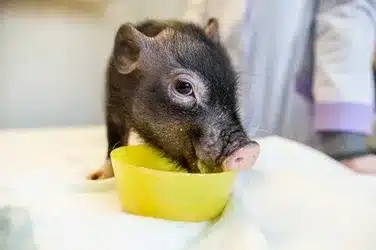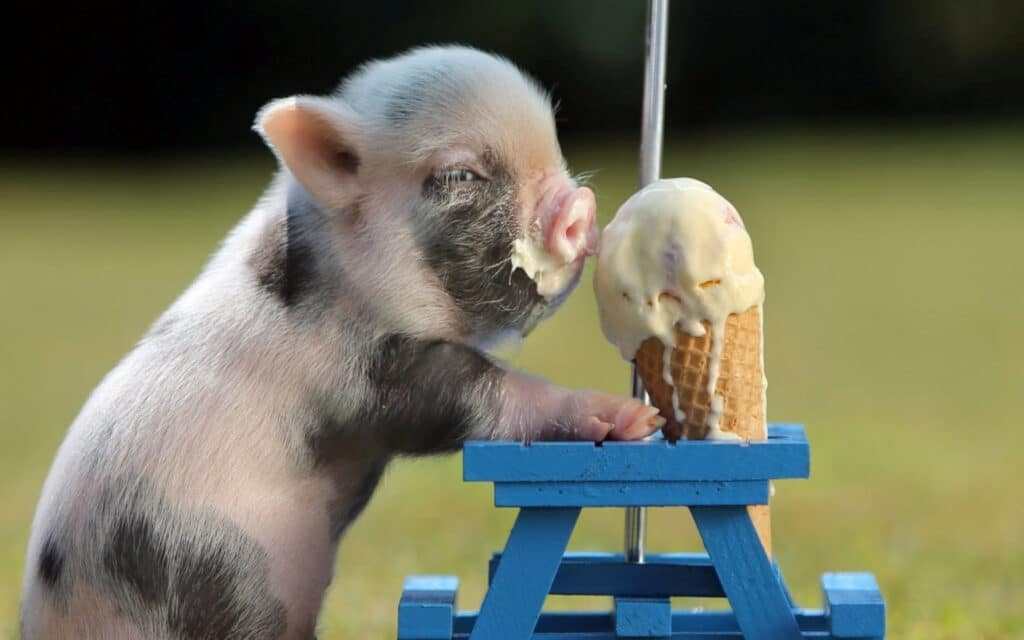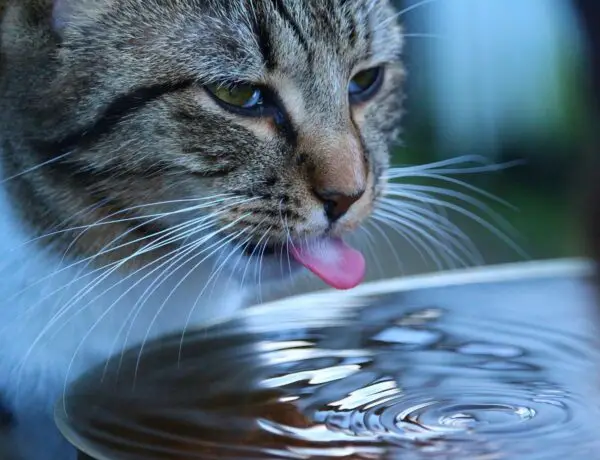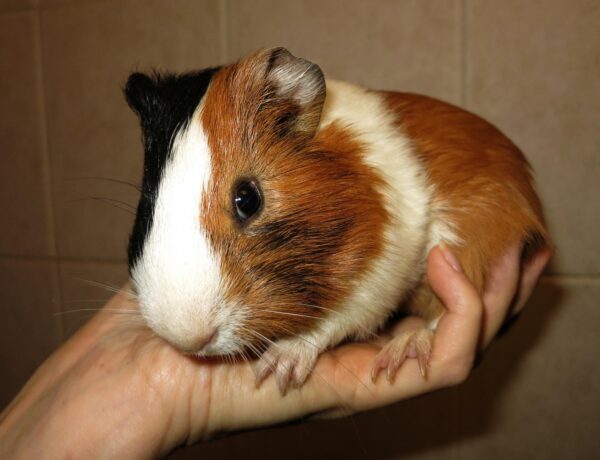Introduction
Pigs, as domesticated animals, have adapted over centuries to thrive in various environments and dietary conditions. Their ability to consume a wide range of foods has made them an indispensable part of the agricultural landscape. Whether they are raised for meat production, kept as pets, or utilized for other purposes, knowing what delights their taste buds is crucial for their health and well-being.
In this exploration, we will not only uncover the culinary preferences of pigs but also delve into the nutritional aspects of their diet. From the basics of what they eat in the wild to how their preferences are met in different farming practices, this journey promises to be both informative and engaging.
Join us as we dive into the intriguing world of porcine palates, discovering what makes these animals tick when it comes to their favorite foods and how their dietary choices are interconnected with their biology and history. Whether you’re a pig enthusiast, a farmer, or simply curious about the gastronomic lives of these intelligent creatures, this exploration into what pigs like to eat will offer valuable insights and perhaps even a few surprises along the way.

What is a pig’s favorite food?
Most pigs love: cooked broccoli, pitted apricots, cucumbers, dark green lettuce, cooked potatoes, beets, grapes, pumpkins, all squashes, zucchini, snow peas, spinach, yams, kale, tomatoes, chard, carrots, pears, apples, berries, oranges, grapefruit, melons, pitted cherries, pitted peaches.
Pigs are known for their diverse and voracious appetites, making it challenging to pinpoint a single favorite food. However, if we were to narrow it down, grains, particularly corn and barley, are often considered some of a pig’s top choices. These starchy grains provide essential carbohydrates for energy and are commonly included in commercial pig diets.
Aside from grains, pigs relish a variety of foods, including vegetables like carrots, potatoes, and leafy greens. Fruits, such as apples and watermelon, are also high on their list of favorites. Pigs are natural foragers and enjoy rooting around for insects, grubs, and even small rodents when allowed to roam in more natural environments.
Pigs are omnivores, which means they’ll happily consume animal-based foods as well. This might include kitchen scraps, dairy products, and even leftover meat or fish. However, a balanced diet is crucial for their health, and commercial pig feeds are formulated to meet their nutritional requirements.
In summary, while pigs don’t have a singular favorite food, their diverse diet reflects their omnivorous nature. They enjoy a wide range of foods, from grains and vegetables to fruits and the occasional meaty treat. A well-balanced diet ensures their health and happiness, making them one of the most adaptable and opportunistic eaters in the animal kingdom.
What do pigs eat in India?
Pigs will eat anything. They will eat grass and all types of plants. They can be kept in a well fenced field where they will eat all of the plants and grass there. The pig not only eats the green parts of plants but will also dig into the ground and eat all the roots.
Pig diets in India, like in many parts of the world, can vary widely based on factors such as regional traditions, farming practices, and the intended use of the pigs. In India, pigs are raised for various purposes, including meat production, waste management, and as a source of livelihood for some communities.
Grains and Vegetables: In rural areas of India, where pigs are often raised for meat production, their diet typically consists of grains like rice, wheat, and sorghum, supplemented with vegetables such as kitchen scraps, green leafy vegetables, and root crops like sweet potatoes. These items are relatively inexpensive and readily available in many regions.
Natural Foraging: In some parts of India, particularly in tribal or forested regions, pigs are allowed to forage freely. They scavenge for food in the form of roots, tubers, insects, and other natural resources. This foraging behavior complements their diet and reduces the cost of feeding.
Commercial Pig Feeds: In more industrialized or commercial pig farming operations, specially formulated pig feeds may be used. These feeds are designed to meet the specific nutritional needs of pigs at different life stages, ensuring optimal growth and health.
Kitchen Scraps and Leftovers: In households and smaller-scale backyard farming, pigs are often fed kitchen scraps and food waste, reducing food wastage and providing an environmentally friendly means of disposal.
Local Traditions: The diet of pigs in India can also be influenced by local customs and traditions. In some regions, there may be religious or cultural restrictions on what pigs are fed.
Do pigs eat bananas?
Bananas can be fed to pigs either fresh, ensiledor in the form of a dry meal, even though the latter is extremely difficult to achieve. Ripe bananas are very palatable and their degree of ripeness affects performance.
Yes, pigs can and do eat bananas, and they often enjoy them as a tasty treat. Bananas are a nutritious and energy-rich fruit that can be a healthy addition to a pig’s diet when fed in moderation.
Bananas are a good source of vitamins, particularly vitamin C and vitamin B6, as well as dietary fiber. These nutrients can contribute to a pig’s overall health. Additionally, bananas contain natural sugars like fructose, which provide a quick energy boost for pigs.
Feeding pigs bananas can be a great way to supplement their regular diet, which typically consists of grains, vegetables, and commercial pig feed. However, it’s important to offer bananas as an occasional treat rather than a primary food source. Like any treat, feeding bananas in excess can lead to weight gain and other health issues, so moderation is key.
When feeding pigs bananas, it’s best to offer them ripe or slightly overripe bananas. Pigs may not be as interested in green or unripe bananas, and the softer texture of ripe bananas is easier for them to eat.
What can pigs not eat?
Meat, meat products and any food that is served on the same plate or that has come into contact with meat is prohibited feed and must not be fed or supplied for feeding to pigs. Dairy products from overseas are also banned. Food that cannot be fed to pigs include: salad and vegetables that have been served with meat.
Pigs, despite their reputation as omnivorous and voracious eaters, should avoid certain foods and substances for the sake of their health. Here are some things that pigs should not eat:
Moldy or Spoiled Food: Just like humans, pigs can suffer from food poisoning. Feeding them moldy or spoiled food can lead to digestive issues and illness.
Processed Foods: Highly processed foods, especially those high in salt and sugar, should be avoided. These can be detrimental to a pig’s health and contribute to obesity and other health problems.
Toxic Plants: Pigs should not have access to plants that are toxic to them, such as rhubarb, nightshade, and certain types of mushrooms. These can be harmful or even fatal if ingested.
Meat from Sick Animals: Feeding pigs meat from animals that died from disease or were euthanized is a risky practice, as it can introduce pathogens and diseases into the pig’s diet.
Onions and Garlic:
These vegetables contain compounds that can be toxic to pigs in large quantities. Small amounts are usually not harmful, but it’s best to avoid them.
Large Quantities of High-Fat Foods:
While pigs do need some fat in their diet, excessive fatty foods can lead to obesity and related health problems.
Alcohol:
Alcohol, even in small amounts, is harmful to pigs. It can cause digestive issues and damage internal organs.
Caffeine:
Just like alcohol, caffeine is harmful to pigs and should not be given to them.
Dairy Products:
While pigs can consume dairy, many of them are lactose intolerant, so dairy products can cause digestive upset.
Are pigs vegetarian?
The first thing to know about pigs is that they are not vegetarians. They are omnivores and their food choices pose no ethical dilemmas for them. Left to their own devices, pigs will readily eat meat.
Pigs are not vegetarians; they are omnivores by nature. While their diet can include plant-based foods, they also have a natural inclination to consume a variety of animal matter. This omnivorous diet is a result of their evolutionary history and digestive capabilities.
In the wild, wild boars and their ancestors primarily forage for a wide range of plant materials, including roots, tubers, fruits, and vegetation. However, they are also opportunistic hunters, eagerly devouring insects, small rodents, and other small animals when the opportunity arises. This adaptation allows them to obtain essential nutrients like protein and fat from animal sources when plant-based options are scarce.
Domesticated pigs maintain this omnivorous nature. They are typically fed a diet that includes grains, vegetables, and commercial pig feed to provide the necessary nutrients for growth and health. Occasionally, they are also given scraps from human meals, which might include meat, dairy, and other non-vegetarian items.
While pigs can thrive on a vegetarian diet supplemented with plant-based protein sources, it’s important to recognize their natural inclination towards omnivory. This diversity in their diet not only contributes to their nutritional needs but also showcases their adaptability and opportunistic feeding behavior. So, while pigs can certainly eat a vegetarian diet, they are inherently omnivores.
How much does a pig eat per day in KG?
Daily Feed Requirements
Give lactating sows 2.5 kg a day of sow and weaner meal for maintenance and 0.25 kg a day extra for each piglet being suckled. Boars: Give boars 2.0 kg a day. If the boar is regularly used, increase this to 2.5 kg.
The daily food intake of a pig can vary significantly depending on several factors, including its age, size, breed, and activity level. On average, a mature pig, such as a market-weight pig raised for meat production, can consume anywhere from 2 to 4 kilograms (4.4 to 8.8 pounds) of food per day. This food typically consists of a balanced diet of grains, vegetables, and commercial pig feed formulated to meet their nutritional needs.
Piglets, on the other hand, require less food when they are very young, usually around 0.5 to 1 kilogram (1.1 to 2.2 pounds) of milk or milk replacer per day, gradually increasing as they grow. As they transition to solid food, their daily intake will also increase.
It’s important for pig farmers and caregivers to monitor individual pig’s appetites and adjust their feeding accordingly to ensure they maintain a healthy weight and condition. Factors like temperature, season, and the pig’s overall health can also influence its daily food consumption. Proper nutrition and portion control are key to raising healthy and well-nourished pigs.
Which state eats the most pig in India?
Much of this demand is met from imports from other states in India and from Myanmar. North East India has much higher pork consumption than the rest of the country. Of these states, Nagaland has the highest per capita consumption.
In India, the consumption of pork varies significantly from state to state due to cultural, religious, and regional dietary preferences. The northeastern states of India, such as Nagaland, Mizoram, Manipur, and Arunachal Pradesh, have the highest per capita consumption of pork in the country. Pork is a staple and an integral part of the cuisine in these states, often prepared in various traditional and flavorful dishes.
The northeastern states have a predominantly Christian population, and pork is a favored meat among Christians. Moreover, many indigenous tribal communities in these regions have a long history of pig farming and incorporate pork into their daily meals.
Conversely, in several northern and western states of India, the consumption of pork is relatively low. This is largely due to cultural and religious factors, as a significant portion of the population in these regions follows Hinduism or Islam, which often prohibits the consumption of pork.
While the northeastern states are known for their high pork consumption, it’s important to recognize that India is a diverse country with a wide range of dietary habits influenced by factors like religion, tradition, and geography. As such, the preference for pork varies considerably from state to state across the nation.
Do pigs need a lot of food?
Because a pig eats approximately 4% of its body weight per day, they require a number of essential nutrients to meet their daily needs, i.e., water, carbohydrates, fats, protein (amino acids), minerals, and vitamins.
Pigs do require a substantial amount of food, but the quantity can vary depending on several factors, including their age, size, breed, activity level, and purpose. Pigs are known for their hearty appetites, and they are efficient at converting food into body weight.
Growth Stage:
Piglets require less food when they are very young, gradually increasing their intake as they grow. A typical weaned piglet may consume around 0.5 to 1 kilogram (1.1 to 2.2 pounds) of food per day initially, but this can increase significantly as they reach market weight
Mature Pigs:
Mature pigs, raised for meat production, can consume an average of 2 to 4 kilograms (4.4 to 8.8 pounds) of food per day. This diet typically consists of grains, vegetables, and commercial pig feed to meet their nutritional requirements.
Breeding Sows:
Pregnant and lactating sows have increased nutritional needs, and they may require 2 to 3 times more food than a non-breeding pig of the same size.
Activity Level:
Pigs that are more active, such as those raised in free-range systems, may need slightly more food to support their increased energy expenditure.
Breed and Genetics:
Some pig breeds are more efficient at converting food into weight gain than others, which can affect their food requirements.
While pigs do eat a substantial amount, it’s essential to provide them with a balanced diet to ensure their health and prevent obesity or malnutrition. Monitoring their food intake and adjusting it according to their individual needs is crucial for proper pig care. Proper nutrition is essential to raising healthy, well-nourished pigs, whether they’re raised for meat, breeding, or as pets.

Conclusion
understanding what pigs like to eat is not only essential for their well-being in various farming contexts but also offers a fascinating glimpse into the dietary preferences of these remarkable animals. Pigs, as omnivores, have a versatile palate, capable of enjoying a wide array of foods ranging from grains and vegetables to the occasional, unexpected treats. Their culinary inclinations are not just a matter of taste but are deeply rooted in their biological needs and evolutionary history.
By exploring the world of pig palates, we gain valuable insights into how to provide for their nutritional requirements and ensure their health and happiness. Whether they are raised on traditional farms, kept as pets, or play a role in animal conservation efforts, catering to their preferences is paramount.
Ultimately, the quest to understand what pigs like to eat is a journey that highlights the intricate interplay between nature and nurture, showcasing the adaptability and intelligence of these animals. As we continue to refine our knowledge of their dietary needs, we enhance our ability to care for and appreciate these endearing creatures as an integral part of our agricultural heritage and the wider world of animal companionship.





No Comments